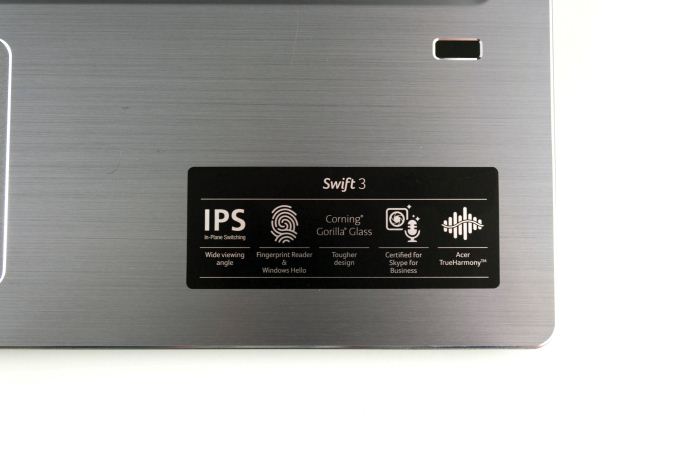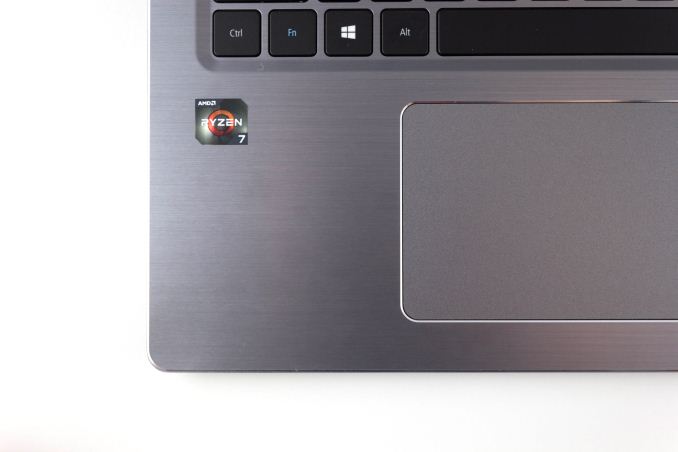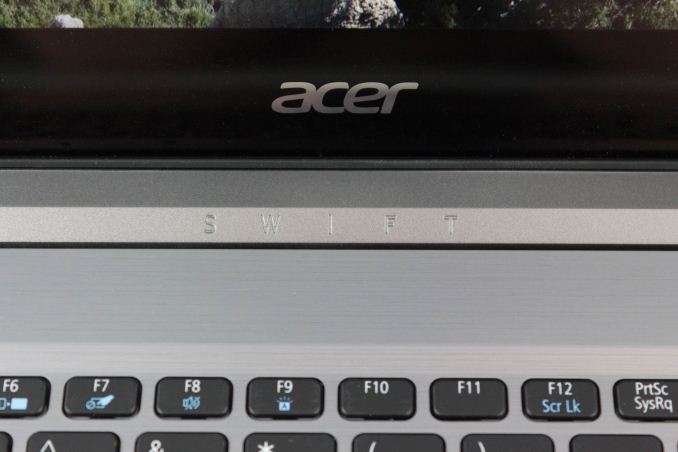The Acer Swift 3 SF315-41 Review: Ryzen Meets Laptop
by Brett Howse on May 3, 2018 8:00 AM EST- Posted in
- Laptops
- Acer
- AMD
- Ryzen
- Ryzen Mobile
- Raven Ridge
Final Words
This review is really looking at two things. First, the Acer Swift 3, and second, the AMD Raven Ridge platform based on Ryzen mobile. Let’s start with the laptop.
Acer’s Swift lineup features models from the Swift 1 at the value end, to the Swift 7 at the top end. So, the Swift 3 is closer to the value end than Acer’s flagship models. But that’s somewhat deceptive because Acer’s Swift 3 is a nicely built device, with a great aluminum exterior, an IPS display, SSD storage, and even a fingerprint reader alongside the excellent trackpad.
It’s not all sunshine and roses for the Swift 3 though. The keyboard is not only cramped with the number pad squeezed in on the right, but the keys themselves are also very poor, with a slippery texture that makes it very easy to miss the key you’re looking for. It does feature backlighting, but the backlighting turns off quickly, and using the trackpad doesn’t light up the keys like it does on most laptops.
The small battery also cuts into the maximum life when not plugged in, and that’s purely a cost decision because there’s plenty of room inside a notebook this big for more battery. Plus, the high baseline power draw pulls down the battery life as well. Compared to a couple of years ago, the battery life is still quite good, but it’s definitely not all day by any means.
The display has great grayscale and white levels, but doesn’t even come close to covering the entire sRGB spectrum, which is something that most laptops do now. At 1920x1080, it does offer enough resolution at least, and of course it’s IPS which is a requirement at this point.
AMD’s Raven Ridge platform has done very well though. The CPU performance is much stronger than the outgoing Carrizo notebook platform, although it’s not quite up to the latest Kaby Lake in terms of absolute performance. But the addition of a real GPU onto the SoC is a welcome change, and allows actual 3D gaming even on a 15-Watt processor. The performance of the Vega GPU is so much better than the Intel integrated solution that really adds a lot of capability.
The combination of AMD’s Ryzen mobile, along with a good design, and excellent specifications for the price, really do make the Acer Swift 3 an appealing proposition. We’ve never tested a laptop at this price point with a 512 GB SSD before, and the 8 GB of DDR4 is very welcome as well at this price. If you can get over the poor quality keyboard, there’s a lot of laptop for the dollar here, and the ability to actually run real games is a welcome change.













78 Comments
View All Comments
neblogai - Friday, May 4, 2018 - link
It is not reasonable to wish an integrated GPU with ~30Gbps memory bandwidth to demolish discrete GPUs that by themselves have higher TDP than this APU, and also double or triple the memory bandwidth. Showing the same result as 940MX is a wonderful result- as AMD solution does the same with no need for extra dGPU and memory chips on the motherboard, and cooling for them. And if more GPU power is needed- then discrete GPU should be used for AMD's laptop as well- games will run great with it's fast quadcore CPU.niva - Tuesday, May 8, 2018 - link
It's very reasonable to expect an APU system to deliver better battery life, especially in idle power scenarios, than one running a core i7 with a discrete GPU. Either something is wrong with this system, they forgot to change some setting in the BIOS, or this is a complete failure on the part. The idea that this is a gaming laptop is just stupid. It's an ultra book, with better graphics capabilities than an integrated Intel chipset, but still an ultra book. I'm not even talking about performance here, I'm strictly talking battery life.Also, the idea of just adding a discrete GPU to an ultra book... never mind.
neblogai - Tuesday, May 8, 2018 - link
Discrete GPU is switched off in non-gaming, so it is basically AMD APU vs Intel APU working. It is true that Intel's chips are more efficient- after all- for many generations Intel were milking desktop with quadcores, while investing into being better at low TDP power efficiency. That is at the time when AMD was balancing on the limit of bankruptcy, and staying in survival mode till Zen arrived. So- AMD sure has a lot to improve with their design, and OEMs- with laptop designs/optimisations when using AMD APUs.As for using discrete GPU in a Ultrabook- just have a look at a ASUS Zephyrus GM501 which is 2cm thin and has a GTX1070 and other no-compromise parts. And there are at least 3 lower tier chips from nVidia alone that sip less power, making gaming on an Ultrabook possible.
samal90 - Thursday, May 3, 2018 - link
That GPU power though. I can't wait to see what next year's APUs will be like with the 7nm Navi. Intel might as well just drop the R&D for integrated graphics and license from AMD like they did with the Vega.keg504 - Thursday, May 3, 2018 - link
What is CABC?Brett Howse - Thursday, May 3, 2018 - link
Content Adaptive Backlight Control. It can change the brightness depending on what's on the screen as a way to cut power draw, but it can be kind of annoying especially when it can't be disabled.keg504 - Friday, May 4, 2018 - link
Oh, thanks.Is this a recent feature OEMs have started implementing? This is the first time I'm seeing it in a review
iwod - Thursday, May 3, 2018 - link
I think there is something wrong with Ryzen JS vm benchmarks.Ryan Smith - Thursday, May 3, 2018 - link
That's what we thought. But everything repeatedly checks out and we can find no systematic flaws. It looks like it just takes the 2700U a bit too long to respond to short, bursty workloads.iwod - Friday, May 4, 2018 - link
Interesting. Would there be a small pieces on this topic specifically?Or in other words, Intel is very aggressive with their Turbo?
Also wondering if the Adrenaline drivers made any difference.